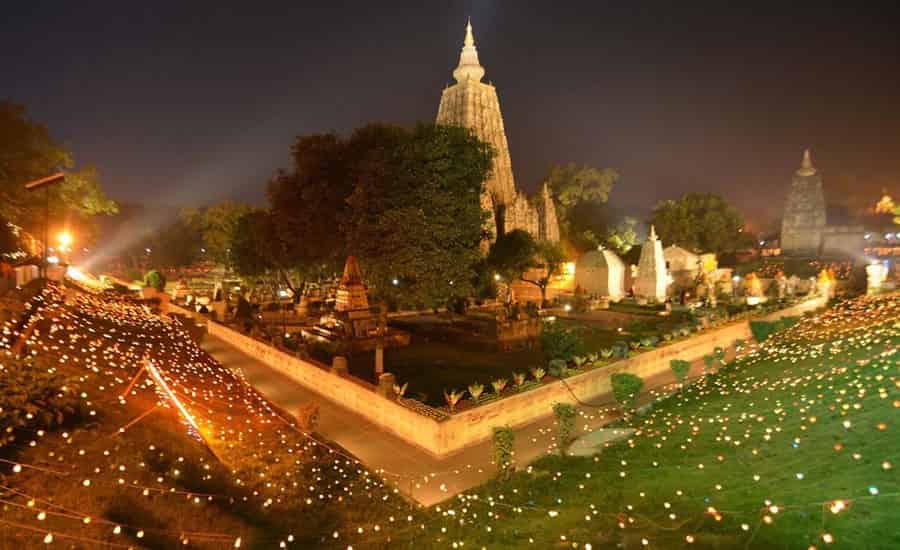The Mahabodhi Temple, located in Bodh Gaya, Bihar, India, is one of the most revered and significant pilgrimage sites for Buddhists around the world. This ancient temple is closely associated with the enlightenment of Lord Buddha and stands as a symbol of his spiritual realization. The temple attracts thousands of devotees and tourists every year who come to witness the sacred rituals and experience the profound spiritual ambiance that surrounds this holy place.
- Deity: Lord Buddha (Gautam Buddha)
- Address: Bodh Gaya, Bihar 824231
- Entry Fee: No Entry Fee
- Best Time to Visit: November to February and March to May
- Darshan Timings:
- 5:00 am – 12:00 pm
- 2:00 am – 9:00 pm

History and Significance
The Mahabodhi Temple, a UNESCO World Heritage Site, has a rich history that dates back to the 3rd century BCE. It is believed to be the spot where Siddhartha Gautama, later known as Buddha, attained enlightenment under the Bodhi tree. Emperor Ashoka, a devout follower of Buddhism, is credited with the construction of the original Mahabodhi Temple in the 3rd century BCE.
The current temple complex is an architectural marvel, reflecting a blend of various influences, including Indian, Burmese, Chinese, and Thai. The main temple stands at a height of 55 meters and features an intricately carved spire. The sacred Bodhi tree, a direct descendant of the tree under which Buddha meditated, is also a focal point of the complex.
- Also Read: Buddhist Pilgrimage Sites in Bihar
Temple Timings
The Mahabodhi Temple is open to visitors throughout the week, allowing devotees and tourists to experience the spiritual aura at various times of the day. The typical timings are as follows:
Morning: The temple opens early in the morning, usually around 5:00 AM. This is a serene time to visit, as the surroundings are relatively quiet, and devotees can engage in meditation and prayer without the hustle and bustle of later hours.
Daytime: The temple remains open throughout the day, providing ample opportunities for visitors to explore the various shrines, stupas, and meditation spots within the complex. Pilgrims often circumambulate the Mahabodhi tree, deepening their connection with the historic events that unfolded here.
Evening: As the day progresses, the temple continues to welcome visitors until around 9:00 PM. The evening hours are especially enchanting, with the soft glow of lights illuminating the temple complex. Devotees often participate in evening prayers and meditation sessions during this time.
Timings and Rituals at Mahabodhi Mahavihara
- 5:00 AM: Commencement of the Mahabodhi Mahavihara, the main shrine.
- 5:30 AM to 6:00 AM: Sutta chanting and meditation session.
- 10:00 AM: Offering of Kheer, a rice pudding prepared with rice, milk, and sugar.
- 12:00 PM to 2:00 PM: Shrine closed for darshan (worship and viewing).
- 6:00 PM to 6:30 PM: Sutta chanting in the Mahayana tradition.
- 6:30 PM to 7:00 PM: Sutta chanting in Pali.
- 9:00 PM: Closure of the Mahabodhi Mahavihara for the day.
Rituals and Practices
The Mahabodhi Temple is a center for Buddhist rituals and practices, offering a unique spiritual experience for those seeking a deeper connection with their faith. Some of the prominent rituals and practices observed at the temple include:
Meditation: The temple complex provides tranquil spaces for meditation, allowing devotees to follow in the footsteps of Buddha and engage in contemplative practices. Many visitors, both novice and experienced meditators, find the peaceful atmosphere conducive to inner reflection.
Puja Ceremonies: Regular puja ceremonies are conducted at the temple, involving the offering of prayers, incense, flowers, and lamps. These ceremonies are attended by both resident monks and pilgrims, creating a sense of unity and devotion among the participants.
Circumambulation: Devotees often perform circumambulation (pradakshina) around the sacred Bodhi tree, the central point of the temple complex. This ritual is a symbolic act of reverence and signifies the devotion of the pilgrims to the Buddha and his teachings.
Chanting of Sutras: The recitation of Buddhist scriptures, known as sutras, is a common practice at the Mahabodhi Temple. Monks and devotees gather to chant these sacred texts, creating a harmonious and spiritually charged environment.
Bodhi Tree Worship: The Bodhi tree, a direct descendant of the original tree under which Buddha attained enlightenment, holds immense significance. Pilgrims often offer prayers and perform rituals around the Bodhi tree, seeking blessings and spiritual enlightenment.
Festivals:
Buddha Jayanti:
- Date: Vaisakh Full moon day (every year in May).
Kathina Civara Dana:
- Date: October month.
Ambedkar Jayanti:
- Date: 14th April.
Monlam Puja & Peace Ceremony:
- Duration: December to February.
Bauddha Mahotsava:
- Dates: 15th to 17th January.
- Suggested Tour: Book Special Gaya Holiday Packages
Conclusion
The Mahabodhi Temple stands as a timeless testament to the profound impact of Buddha’s teachings on humanity. The temple’s rich history, coupled with its spiritual significance, draws people from all walks of life to seek solace, enlightenment, and a deeper connection with their inner selves. The rituals and practices observed at the temple provide a transformative experience for those on a spiritual journey, making it a cherished destination for Buddhists and a place of curiosity and admiration for people of diverse faiths and backgrounds.
Also Read:

 Call
Call WhatsApp
WhatsApp Enquiry
Enquiry